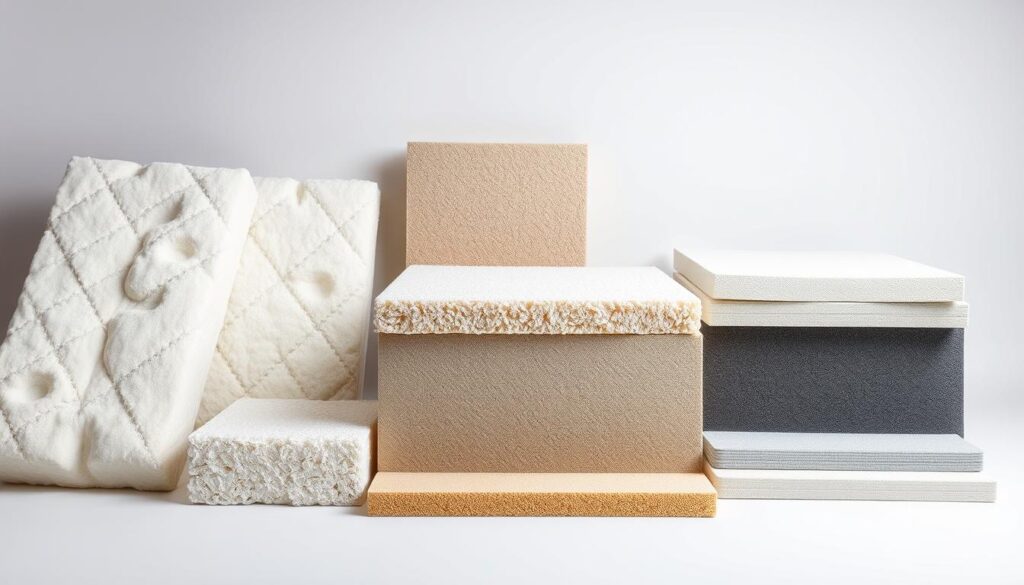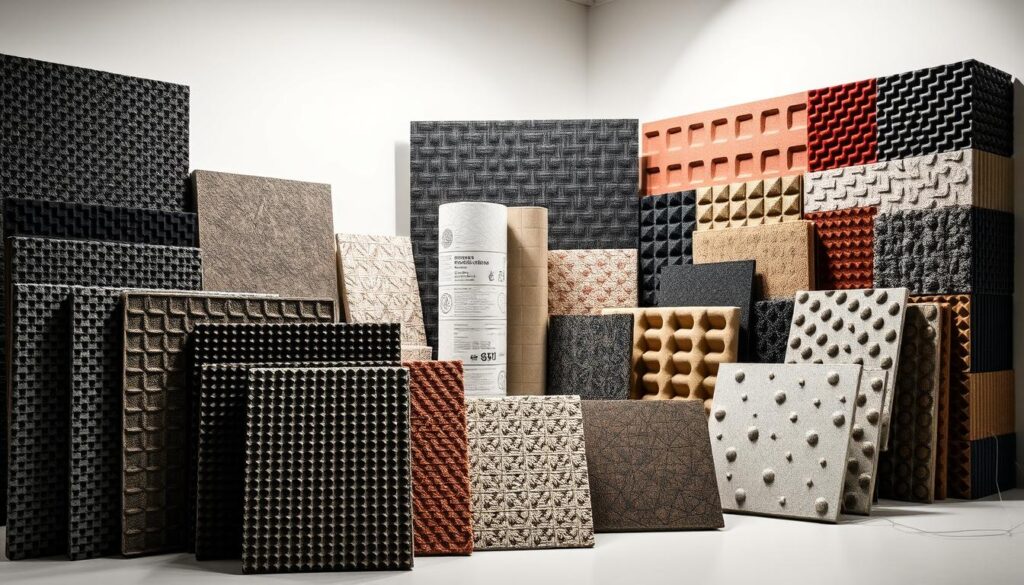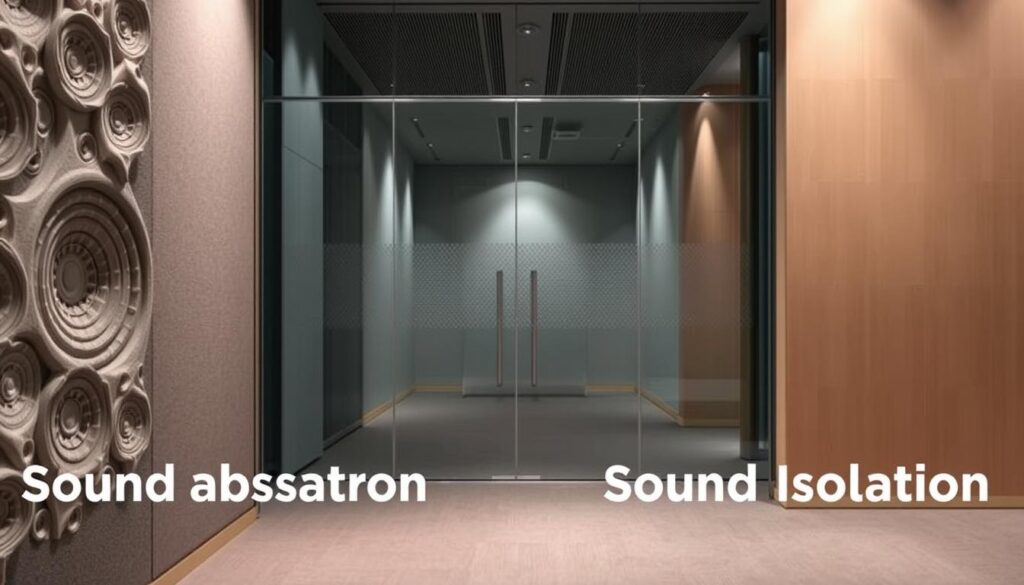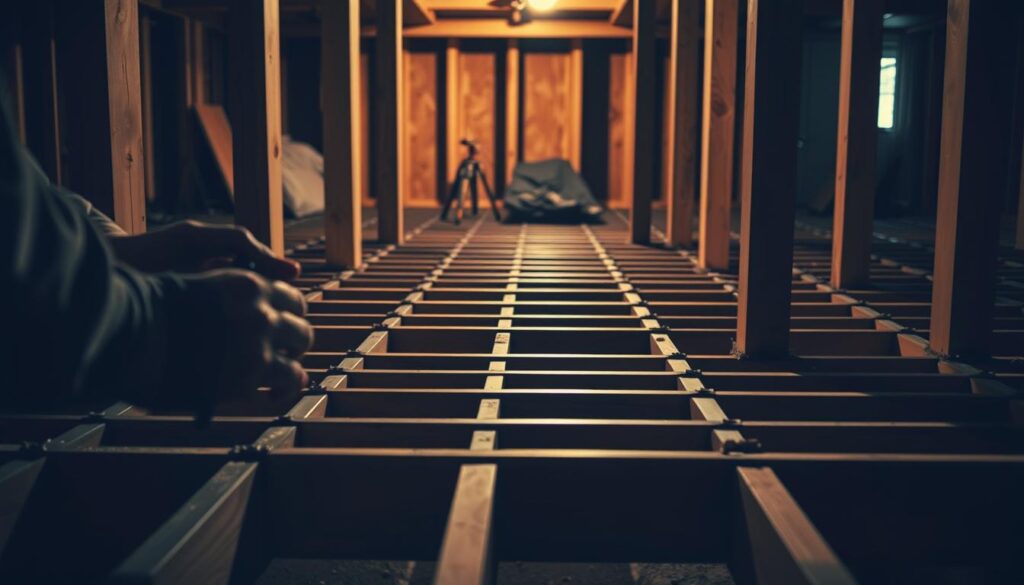Soundproofing is key in building construction. It helps cut down on unwanted noise and boosts life quality. Effective soundproofing needs the right insulation materials to block noise.
There are many soundproofing materials out there. It’s important to know their strengths and weaknesses. This article will look at the good and bad sides of different insulation materials for soundproofing. We’ll cover their benefits, drawbacks, and uses.
Knowing your options helps you choose the best one. This way, you can make your space quieter and more comfortable.
Understanding Soundproofing Basics
To soundproof a room well, you must grasp the basics. It’s not just about stopping noise. It’s about understanding how sound moves and how to manage it.
Soundproofing stops sound waves from entering or leaving a room. It uses deflection, absorption, decoupling, thermal conversion, and constrained layer damping. Knowing these helps pick the right soundproofing material.
What is Soundproofing?
Soundproofing is about using methods and materials to block sound. It’s key in homes, offices, and factories. Good soundproofing boosts privacy, cuts distractions, and makes spaces more comfortable.
Why is Soundproofing Important?
Soundproofing makes environments more controlled. It’s vital for reducing outside noise or keeping sound in. It’s crucial for places like recording studios, home theaters, and bedrooms where quiet is essential.
Choosing soundproofing materials means looking at more than just sound absorption. Consider R-values, fire resistance, and eco-friendliness too. Different insulations have different benefits, so picking the right one is key.
Types of Insulation Materials for Soundproofing
Choosing the right insulation material is key to successful soundproofing. You have various options available, each with its unique characteristics and applications. The right material can significantly enhance the soundproofing effectiveness of your space.
Acoustic Foam
Acoustic Foam is a popular choice for soundproofing. It’s effective in absorbing sound waves and reducing echo. It’s commonly used in recording studios, home theaters, and other spaces where sound quality is crucial.
The foam’s open-cell structure allows it to dissipate sound energy. This minimizes reverberation.
Mineral Wool
Mineral Wool is another widely used insulation material for soundproofing. It’s known for its high density, which makes it effective in blocking sound transmission. Mineral Wool is also fire-resistant and can provide additional thermal insulation benefits.
Its effectiveness in soundproofing makes it a viable option for both residential and commercial applications.
Both Acoustic Foam and Mineral Wool are effective acoustic insulation materials that can be used to achieve better soundproofing. Understanding the strengths and weaknesses of each material is crucial in selecting the most appropriate solution for your soundproofing needs. By choosing the right material, you can significantly improve the sound quality and reduce noise pollution in your space.
Acoustic Foam Details
Soundproofing with acoustic foam is a common method, but knowing its full impact is key. Acoustic foam is known for absorbing sound waves, making it great for room acoustics and echo reduction. Yet, its soundproofing effectiveness is just part of the story.
When looking at acoustic foam, its advantages are important. It’s great at absorbing sound waves, which cuts down echo and boosts room acoustics. This makes it perfect for home theaters, recording studios, and other places where sound matters a lot.
Advantages of Acoustic Foam
- Effective sound wave absorption
- Improves room acoustics
- Reduces echo and reverberation
- Easy to install
But, acoustic foam also has disadvantages. It’s not as good at blocking sound as other materials, which limits its use. It also has a low R-value, meaning it’s not great for keeping warm. Fire safety and eco-friendliness are also things to think about.
Disadvantages of Acoustic Foam
- Limited sound blocking capability
- Low R-value for thermal insulation
- Potential fire resistance concerns
- Variability in eco-friendliness
In summary, acoustic foam is useful for soundproofing and room acoustics, but it has its limits. Fire safety and environmental impact are also important. Knowing both sides helps you decide if acoustic foam fits your soundproofing needs.
Mineral Wool Insights
Mineral wool is a top choice for sound deadening. It’s dense and blocks sound well. You might pick it for your soundproofing needs.
Mineral wool has many benefits for soundproofing. It’s known for:
- High R-value: It insulates well, keeping temperatures steady.
- Fire resistance: It doesn’t burn, making spaces safer.
- Eco-friendliness: Made from natural or recycled stuff, it’s good for the planet.
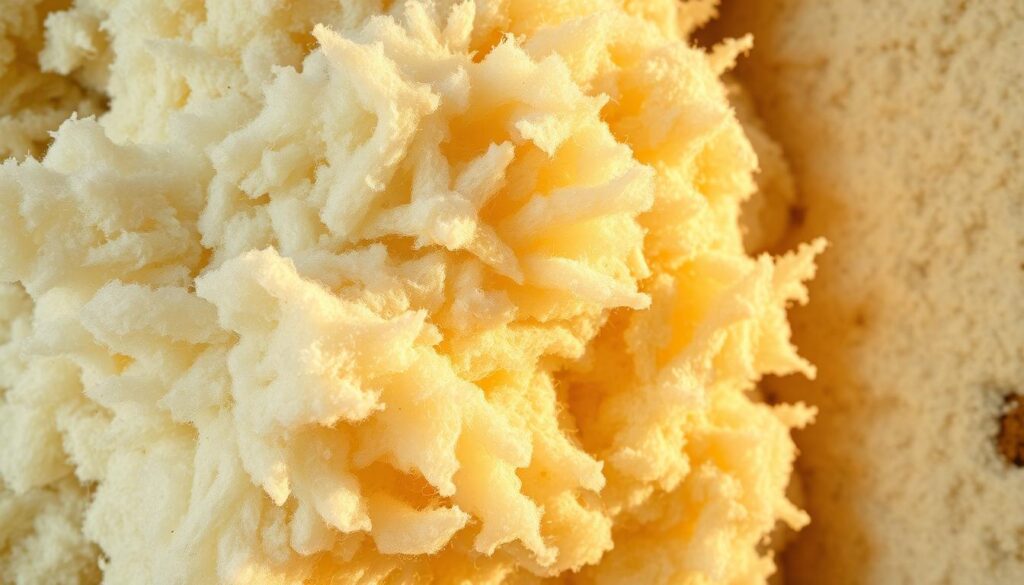
Benefits of Mineral Wool
Mineral wool does more than just block sound. Its density helps it absorb sound well. This makes it great for places like recording studios and home theaters.
Limitations of Mineral Wool
But, mineral wool has some downsides. These include:
- It costs more than some other materials.
- Handling it can cause skin problems and breathing issues if not done right.
Think about these points to decide if mineral wool fits your soundproofing needs.
Evaluating Fiberglass Insulation
When looking at fiberglass insulation for soundproofing, it’s important to know its good and bad points. You should think about how well it blocks sound, its R-value, fire safety, and if it’s good for the environment.
Advantages of Fiberglass Insulation
Fiberglass insulation is liked for many reasons. It’s affordable, has a high R-value for keeping temperatures steady, and is easy to put in, even if you’re doing it yourself.
- Cost-effectiveness: It’s cheaper than many other soundproofing options.
- High R-value: It keeps your home warm in winter and cool in summer.
- Ease of installation: It’s simple to install, making it great for DIY projects.
Also, it’s non-combustible, which means it’s safer from fires. But, it’s important to remember its soundproofing limitations.
Disadvantages of Fiberglass Insulation
Fiberglass insulation has some downsides, mainly for soundproofing. Some of these include:
- Limited soundproofing effectiveness: Studies show it’s not as good at blocking sound as other materials.
- Health risks: Installing it can be risky if you don’t take the right precautions.
- Moisture issues: It can get damaged by moisture, which makes it less effective.
In summary, while fiberglass insulation is good for keeping your home warm or cool, it’s not the best for soundproofing. Think about what you need and consider both the good and bad points before choosing.
Other Insulation Options to Consider
There are many insulation materials for soundproofing your space. Acoustic foam, mineral wool, and fiberglass are popular. But, other materials can also help achieve soundproofing.
Cellulose Insulation
Cellulose insulation comes from recycled paper. It’s eco-friendly and insulates well against heat and cold. It’s also good at absorbing sound, but its soundproofing can depend on how it’s installed.
Spray Foam Insulation
Spray foam insulation seals gaps and cracks well, reducing noise. But, it’s not as good at soundproofing as some materials. It works best with other soundproofing materials.
When picking between cellulose and spray foam, think about your space’s needs. Both can be part of a good soundproofing plan.
Comparing Sound Absorption Rates
To get the best soundproofing, it’s key to look at how different materials absorb sound. Sound absorption rate shows how well a material takes in sound energy, not bouncing it back.
Materials’ soundproofing power can be shown by their Sound Transmission Class (STC) rating. A higher STC means better sound blocking.
Measuring Effectiveness
When checking insulation materials, several things matter. These include sound absorption coefficient, R-value, fire safety, and if it’s eco-friendly. The sound absorption coefficient shows how well a material absorbs sound.
Key Factors in Measuring Effectiveness:
- Sound absorption coefficient
- R-value (thermal resistance)
- Fire resistance
- Eco-friendliness
| Material | Sound Absorption Coefficient | R-Value | Fire Resistance |
|---|---|---|---|
| Acoustic Foam | 0.8-1.0 | 4-6 | Moderate |
| Mineral Wool | 0.7-0.9 | 3-4 | High |
| Fiberglass | 0.6-0.8 | 2.2-4 | Moderate |
| Cellulose | 0.7-0.8 | 3.5-4.5 | High |
Which Material Performs Best?
The top material for soundproofing depends on your needs and what’s important to you. For high sound absorption and some fire safety, Acoustic Foam is a good pick.
Think about these when choosing:
- Your budget
- The soundproofing level you need
- Fire safety worries
- How it affects the environment
By looking at sound absorption rates and other important factors of different materials, you can choose wisely. This ensures your soundproofing needs are met.
Installation Considerations
The success of your soundproofing project depends on careful installation. Whether it’s for a home theater, recording studio, or a noisy office, how you install soundproof insulation matters a lot.
DIY vs. Professional Installation
First, you must decide if you’ll do it yourself or hire a pro. DIY installation can save money and give you full control. But, you need to know your materials and the soundproofing needs of your space well.
Professional installation brings expertise and experience. Pros can suggest the best materials and ensure they’re installed right for the best results.
| Installation Method | Advantages | Disadvantages |
|---|---|---|
| DIY Installation | Cost-effective, control over the process | Requires knowledge and skill, potential for mistakes |
| Professional Installation | Expertise, ensures correct installation | Higher upfront cost, less control over the process |
Preparing Your Space for Installation
Preparation is key, whether you’re doing it yourself or hiring a pro. Clear the area, check for damage, and make sure you have all the tools and materials ready.
By preparing well and choosing the right method, your soundproof insulation will work its best. This will give you the quiet and peace you need.
Cost Analysis of Soundproofing Materials
The cost of materials is key when soundproofing. The price of sound deadening materials can change a lot. It depends on the type and quality. When looking at insulation materials for soundproofing, think about the cost now and later.
Different materials have different prices. For example, acoustic foam is cheaper than spray foam insulation. Mineral wool falls in between. Knowing these prices helps you choose within your budget.
Budget-Friendly Options
If you’re watching your budget, there are affordable sound deadening materials. Fiberglass insulation is cheap and works well. Cellulose insulation is also budget-friendly and good for the planet.
- Fiberglass insulation: Affordable and widely available.
- Cellulose insulation: Eco-friendly and cost-effective.
- Acoustic panels: Can be DIY or purchased at a relatively low cost.
For more info on soundproofing walls, check out Soundproof Spaces. They have lots of soundproofing solutions.
Long-Term Investment Considerations
Cost is important, but so are long-term benefits. Spray foam insulation costs more but lasts longer and saves energy. Mineral wool is durable and fire-resistant, worth the extra cost.
| Material | Initial Cost | Long-Term Benefits |
|---|---|---|
| Fiberglass Insulation | Low | Decent soundproofing, relatively affordable. |
| Spray Foam Insulation | High | Superior soundproofing, energy efficiency. |
| Mineral Wool | Medium-High | Durable, fire-resistant, good soundproofing. |
In conclusion, balancing cost and benefits is key. Choose materials that fit your budget and needs. This way, you make a smart choice for soundproofing and your wallet.
Maintenance of Soundproofing Insulation
To keep your soundproofing solutions working well, regular maintenance is crucial. Proper care extends the life of your acoustic insulation materials and keeps them performing at their best.
Different materials need different care. For example, acoustic foam can be dusted with a soft brush or vacuumed gently. But, mineral wool needs more careful handling to avoid damage. It’s important to check your insulation often for wear or damage.
Maintaining Different Materials
For fiberglass insulation, it’s key to check for any compression or damage. If you find damage, it’s best to replace the affected area. This keeps your soundproofing effective.
- Regularly inspect your insulation for signs of damage or wear.
- Clean your insulation according to the manufacturer’s instructions.
- Avoid compressing or damaging the insulation during maintenance.
Signs You Need to Replace Insulation
Even with good care, insulation may need to be replaced over time. Look for a drop in soundproofing, visible damage, or moisture. If you see these signs, it’s time to replace your insulation.
By keeping up with maintenance and knowing when to replace, you can keep your soundproofing solutions effective. This ensures your space stays quiet and peaceful.
Deciding on the Best Insulation Material for Your Needs
Choosing the right soundproof insulation materials is important. You need to think about how well they work, their cost, and their impact on the environment. The best materials should be effective, affordable, and good for the planet.
Key Considerations
Look at the R-values, fire safety, and if they are eco-friendly. R-values show how well they keep heat out. Fire safety is key to keeping you safe. Eco-friendly options, like recycled denim or cellulose, are better for the planet. Also, think about the material’s cost and how long it lasts.
Making an Informed Choice
To pick the best insulation, weigh the good and bad of each. Think about your budget, where you live, and what you like. By looking into different materials, you can make your space quieter and more comfortable. The right choice depends on your specific needs, so take your time to decide.
